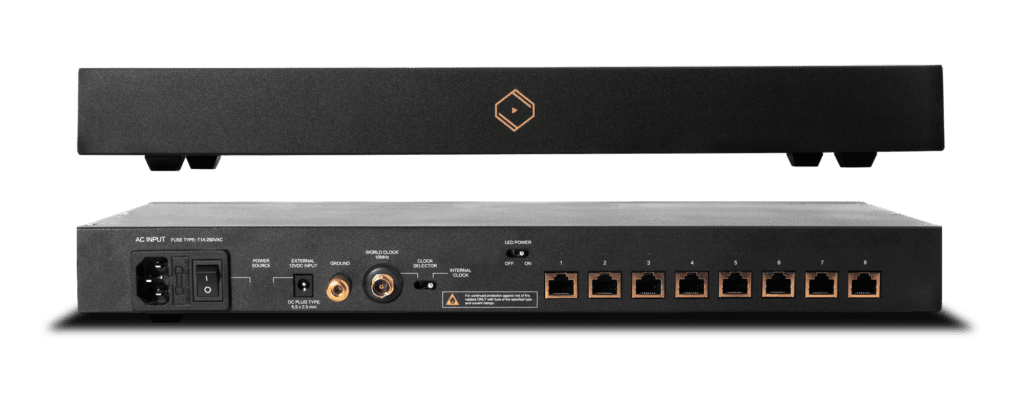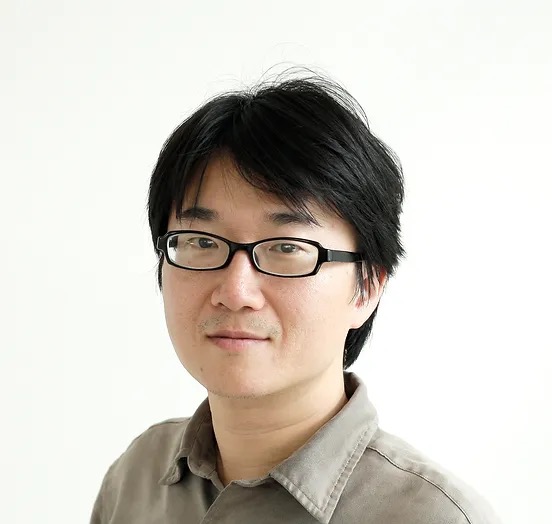My Pursuit of the Ultimate Digital Streaming Experience
— Chorus Chuang, CTO of Silent Angel
This document describes our experiences in researching – and experiments related to – network streaming devices, their impact on sound quality and developing Silent Angel Bonn Series Ethernet switches.

It is common knowledge that digital music has a major advantage, namely, the preservation of data integrity across long distance transmission. Let’s call it the “Lossless advantage.” In the usual design and manufacturing process of IT products, such as a mass market Gigabit Ethernet switch, thorough testing of loss-less data transmission is commonplace. The standard is a 72-hour wide-temperature test, using network packet generators (e.g., SmartBits or IXIA) to inject high-bandwidth data traffic into every single port of a switch device, with no packet transmitted erroneously during the entire test period. This, of course, is a result of standard-following technical work (typically IEEE standard), which is designed to simulate noise and interference during real-life transmission. Thanks to this excellent data preservation technology, we now enjoy the internet as reliably as we have, for more than a century, enjoyed electricity.
Prior to the establishment of Thunder Data (the company that produces and markets Silent Angel products), I shared the belief that digital music was immune to the interference we encounter every day and that music would be reproduced perfectly due to the lossless nature of network data transmission (lost data will be retransmitted, to be exact). Then one day, I conducted a simple test with my entry-level sound system: a main-stream PC running Foobar2000 connected, via USB cable, to a $400 DAC. A Marantz PM4001 amplifier and a pair of home-brew speakers completed the modest system. I read discussions about configuring the output-buffer size of Foobar2000 to improve the sound quality and tested it myself; to my surprise, the change of parameters made a profound sonic difference. I realized that these phenomena were worth investigating. Although data hadn’t been lost during transmission, there were clearly some factors that, though not yet quantified, played important roles in the reproduction of sound.
I started investigating to enhance my own musical enjoyment and organized discussions with a few good friends. Through many conversations and experiments, we discovered quite a few potential avenues for future research. With passion and the desire to advance the quality of digital music reproduction, I initiated some projects and incorporated the Silent Angel brand in 2014.
Initial research focused on a music server: predecessor to our Z1 (The current Rhein Z1 series is a Sixth Generation design). In our server development work, we found that sound quality varied significantly with the user’s network environment, which inspired our work in the quality of network transmission. The first product of this research was the Silent Angel Bonn N8, which debuted in 2019, and provoked numerous forum discussions regarding why a network switch could make a sonic difference. Unfortunately, given the relative novelty of this field, we could not find much prior work to reference. We undertook virtually endless experiments to identify the differences in sonic performance and the reasons behind them. Later, we discovered that at least three design parameters could improve the quality of music: power supply, clock precision, and EMI interference. Thus, based on these three factors, we developed solutions which are embodied in the Bonn N8. In the latest release of Bonn NX, we have implemented additional improvements, including a vastly more advanced chassis design.
Although we heard and confirmed the differences with audiophiles and industry experts, we continue to ask the question: how do we explain in theory the fact that a network switch could significantly impact the sound quality of a digital music system? Let me start answering this question with my first job as a network engineer. My mission then was to develop a Gigabit Ethernet switch using Intel’s early-stage, three-chip solution. During the development work, I was advised by Intel engineers that we needed to use traditional Edison-style incandescent bulbs in the lab in order to pass the IEEE compliance test. Fluorescent lights had to be avoided because they emit high-frequency noise. Thought skeptical, we followed this suggestion and turned off all fluorescent lights. To our surprise, the noise level in our switch significantly dropped, and the product passed the compliance test.
Another example has to do with my development work for a VDSL (Very high-speed Digital Subscriber Line) switch device, which has 24 VDSL ports. VDSL is a technology that connects a dial-up internet connection over telephone lines at up to 100Mbps down-stream and 50 Mbps up-stream speed. In order to make field deployment easier, telecommunication companies used a cable with 24 twisted-pair telephone wires bundled inside. However, we found that some lower-quality cables suffered dramatic crosstalk among the twisted-pairs, to the degree such that connections could even be made by using the neighboring wires due to crosstalk, e.g., Port 1 inbound connected to Port 2 outbound instead of the physically-connected Port 1 outbound. The surprising magnitude of crosstalk among wires demonstrated the need to minimize crosstalk when designing Printed Circuit Board (PCB) layouts and the spacing between Ethernet connectors. We took this philosophy to its ultimate expression in the Bonn NX, where the physical spacing of connectors eliminates the potential for crosstalk while facilitating cable connection.
The third example also has to do with the VDSL switch. Chunghwa Telecom (Taiwan’s biggest telecom company) developed a switch that can support up to 360 users. In order to save space in the rack, this switch is made with a compact metal enclosure. Even a slight imprecision in the layout traces could introduce dramatic cross-talk, which manifested in an unstable link-status. In some cases, it precipitated frequent reconnecting activities.
Why are clock signals an important factor to impact sound quality? In Ethernet transmission, the clock signal is transmitted from the sender (source) to the receiver (destination) concurrently through modulation. When the receiver receives the packet, it will reconstruct the clock signal using the clock-recovery circuit (refer to the attached block diagram*) in order to decode the data in the packet. When the clock signal is unstable in the sender, it can cause the reconstructed clock signal to be unstable. In the worst case, it will cause the network connection to drop; for this reason, Silent Angel employs ultra-high-performance TCXO (Temperature Compensation Crystal Oscillator) Clocks, which virtually eliminate the potential for clocking-related issues.
Another area of our work focused on EMI absorbers. We can explain the role of EMI absorbers using a simple analogy. If we sing in an enclosed room, e.g., in a bathroom, our voice sounds louder and richer (i.e., more reverberant) due to the reflection of sound waves at the walls. If we put sound-absorbing materials (such as sponge) on the wall, our voice will sound lighter. Same for electromagnetic waves. In a small enclosure, electromagnetic waves will be reflected and reinforced by the metal enclosure. If we deploy EMI absorbers at right spots within the enclosure, the electromagnetic waves will be absorbed, converted to heat and then dissipate. This design approach significantly reduces the interference of electromagnetic waves among different components. But we found that EMI absorber impacts not only the electromagnetic wave but also the high-frequency analog signals. In some cases the absorbers eliminate the high-frequency signals and cause negative effects on sound quality. Hence the EMI absorbers we place in Munich and Bremen products specifically avoid influencing the analog circuit and signals. To apply the absorber at the exact right spots and with the right amount of absorption is the result of careful experimentation and refinements. Silent Angel has devoted significant time and effort to specifying the proper EMI absorbers for each specific product and installing these at the precise locations within each chassis to reduce EMI without affecting tonal balance, detail, etc.
Next comes the question: why do clock signals to the Ethernet switch impact sound quality of a digital music player? In our experience, various components in the receiving end can be affected. When the switch does not have a stable clock source, the receiving device’s circuits will consume more power in order to complete the recovery of clock signals. It will indirectly affect the power source of the receiving device as well as the noise floor. If this receiver device is connected to a DAC and/or an amplifier, this subtle change of power source will negatively impact their analog circuits as well. Similar explanation can be given regarding the importance of the power source to the Ethernet switch. When the power source of an Ethernet switch is unstable, the network signals produced using the power source will carry more noise, which is propagated to the receiving end (typically a player). Ultimately the instability affects the sound produced by the entire system. Silent Angel solves this problem through the use of large, high-stability power supplies and the ability to add outboard, Linear Power Supplies (LPS) such as our Forester F1 and F2, which offer further sonic improvements. In similar fashion, the superior TCXO clocks employed in Bonn N16, N8 Pro and NX were selected for their audible superiority. Again, the Bonn NX takes clock upgrading to its ultimate expression, incorporating a dedicated input for an outboard clock signal generator.
As discussed above, network traffic through different physical ports of an Ethernet switch induce crosstalk. We therefore need to consider circuit and component separation in the switch design to mitigate crosstalk. All Silent Angel Network Switches feature critically-spaced ports as well as precisely laid-out components and board traces to minimize crosstalk and other noise. Commodity-grade Ethernet switches don’t even acknowledge these mentioned optimizations, hence, we introduced the concept of the “Audio-Grade Switch (AGS)” and authored Bonn N8, N8 Pro, and newly released NX.
No exploration into digital streaming optimization would be complete without mentioning the importance of using good Ethernet cables. There are 4 pairs of wires inside a cable that could introduce crosstalk. Higher-end Ethernet cables have better shielding among those wires to improve the signal quality, which also affects the overall sound quality. Experienced HiFi customers will examine the internal structure of cables before they make the purchase. Silent Angel has already developed the Bastei range of DC cables and is conducting research regarding the optimal design of Ethernet cables.
There are still many unanswered questions in the quest to perfect the presentation of music in the era of digital streaming. Silent Angel engineers are researching and studying continuously. It is both our passion and our mission to help music-lovers resolve the problems they might encounter in their journeys to upgrade and pursue the better sound quality, in order to maximize the advantage of the lossless nature of digital music. In this adventure of relentless pursuit and endeavor, Silent Angel will continue to create exciting and innovative products and services to share with devoted music lovers.
